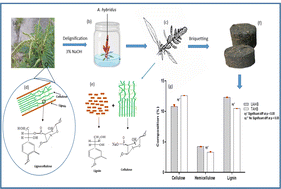Amaranthus hybridus waste solid biofuel: comparative and machine learning studies
Abstract
The diminishing supply of fossil fuels, their detrimental environmental effects, and the challenges associated with the disposal of agro-waste necessitated the development of renewable and sustainable alternative energy sources. This study aims at developing bio-briquettes from Amaranthus hybridus waste, with cassava starch as a binder; both are agricultural wastes. Before and following delignification, alkali-treated Amaranthus hybridus (TAHB) and untreated (UAHB) briquettes were evaluated in terms of combustion and physicochemical parameters. FTIR and SEM were utilized to monitor the morphological transformation and bond restructuring of TAHB and UAHB samples. EDXRF was used to assess the Potential Toxic Elements (PTEs) composition and environmental friendliness of both TAHB and UAHB. Furthermore, Adaptive Neuro-Fuzzy Inference System (ANFIS) and fuzzy c-means (FCM) clustering machine learning models were used to optimize the production process and predict the efficiency of bio-briquettes. After delignification, a lower lignin value of 11.47 ± 0.00% in TAHB compared to 12.31 ± 0.01% (UAHB) was recorded. Calorific values of 10.43 ± 0.25 MJ kg−1 (UAHB) and 12.53 ± 0.30 MJ kg−1 (TAHB) were recorded at p < 0.05. EDXRF results showed a difference of 0.016% in Pb concentration in both samples. SEM reveals morphological restructuring, while FTIR reveals a 4 cm−1 difference in the C–O stretch. The root mean square error (RMSE), mean absolute percentage error (MAPE), and mean absolute error (MAE) gave values of 0.0249, 2.104, and, 0.0249; (MAE, training) and 0.0223 (MAE, testing) respectively. This shows that the model's predictions match the reality, thereby suggesting a strong agreement between the predicted and experimental data. The finding of this study shows that delignification-disruption improved the solid biofuel's ability to burn cleanly and sustainably.



 Please wait while we load your content...
Please wait while we load your content...